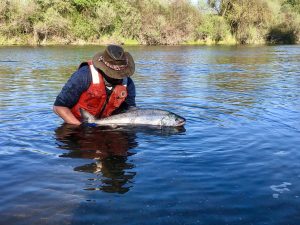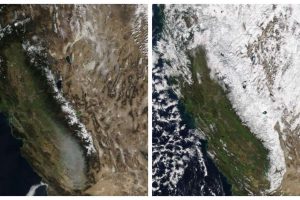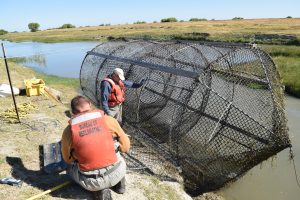
Spring-run Chinook Return to San Joaquin River Despite Low Water Year
2020 Brings Generational Variety, New Information
If there’s one certainty in these uncertain times, it’s that nature is resilient, and one needn’t look further than the San Joaquin River as an example. For a second year in a row, and for only the second year in over 65 years, spring-run Chinook salmon have returned from the ocean to spawn in the river and bring forth the next generation. And with each year the salmon return, the Program gains new insights about the next generations of fish now inhabiting the river, using the data gathered to help guide restoration efforts.
As valley temperatures have skyrocketed in recent weeks and river flows have receded, field crews were forced to curtail monitoring actions on the river (fish require certain water temperature to survive). However, before that happened, crews successfully captured 57 adult spring-run Chinook in the lower reaches of the Restoration Area downstream of the first passage impediment.

“Despite low water conditions, the fish came back,” said San Joaquin River Restoration Program manager Don Portz. “Again, the Program has met another milestone by showing the resiliency of the spring-run population to return even in a low water year,” he said.
These low water conditions are part of what makes the 2020 returns so interesting. 2019, which had an estimated 400-plus adult fish returning to the system, saw late winter storms pushing the year into a “wet” water year type (water year types, based on watershed hydrology, are used to determine the amount of Restoration Flows that are released to the river to benefit fish). While not as dry as during the 2012-2016 drought which saw “critical-high” (second-lowest) and “critical-low” (lowest) water year types, 2020 is still a “dry” water-year type – one of the lower water-year types (from low to highest: critical-low; critical-high; dry; normal-dry; normal-wet; and, wet).
Fish passage in the river is inhibited in lower water years due to water diversion structures. In higher water years, fish can and do get past in-stream obstacles overtopped by high flows, but part of the Program efforts are to modify these structures for passage. However, because of the passage limitations in low-water conditions, field crews must physically capture the fish in fyke nets and transport them in trucks equipped with water tanks for release in the cooler temperatures of Reach 1 below Friant Dam. There, the conditions are such that the fish can successfully spawn due to cold water releases from the dam and suitable spawning habitat.

This year’s returns also illustrate the ability of juvenile salmon to make it out of the system in a variety of water year types.
After spawning, adult salmon die, the eggs hatch a few weeks later and the juveniles make their way out to the ocean for several years before heading back to their native river and starting the lifecycle over again.

To jump-start the spring-run Chinook population in a river that had no spring-run, the Program has re-introduced juvenile spring-run Chinook salmon to the San Joaquin River since 2015 and currently releases upwards of 250,000 annually. The Program also releases smaller numbers of year-old fish, known as yearlings – juveniles that waited a year before migrating out to the ocean and would be found in natural populations – as well as adult fish, for experimental purposes.
The Program’s spring-run Chinook are identified by their brood year, or, the year they were spawned. All of the fish released through the Program are tagged in their snouts using a hair-width coded-wire tag to record their brood year and release date. Coded-wire tags can only be recovered and the information read once the tag is recovered from a carcass, though crews can tell whether a live fish has a coded wire tag using a metal-detecting wand – one way of indicating they are a hatchery vs. wild fish (another is adipose fin clipping). Some fish have additional means of identification, such as passive integrated transponder (PIT) tags, which also contain information that can be read while the fish is alive.
While recovered coded-wire tags from 2019 returns indicate most of the fish came from a singular March 2017 juvenile release group, this year’s returns appear to have greater variety. Based on tags recovered from adult fish in the field, 2020 returns appear to be from several release groups and from different age classes. Information gathered so far includes at least one brood year 2016 fish released in 2017 as a juvenile as well as brood year 2017 fish that were released in 2018 as juveniles and 2019 as yearlings.
So, in addition to the Program’s salmon making it in and out of the system during a variety of water conditions, the burgeoning San Joaquin River spring-run Chinook population has revealed another critical attribute: variety.
“This year we’ve seen multiple cohorts make their way back to the system and that’s critical to a healthy fish population,” said Oliver Burgess, the Program’s Lead Fish Biologist. Cohorts are different generations of fish made different by the years in which they were spawned and the years in which they returned. Historically, adult spring-run in the San Joaquin River took advantage of increased streamflow during spring snowmelt to access tributaries higher in the watershed than are accessible during other seasons. After spawning and fry emergence, a portion of the population would migrate downstream immediately, and others would remain in the upper tributaries and migrate the following year as yearlings. This naturally-occurring strategy helps to ensure that catastrophic ecosystem events, such as drought, a lack of success during outmigration, or an early-onset summer that warms river temperature quickly, do not decimate an entire fish population.
Likewise, adult spring-run employ a strategy to ensure the population persists. Spring-run that spend more years in the ocean, grow larger and produce more eggs, but are also vulnerable to additional sources of mortality (fishing, predation, etc.) for a longer period of time. A group of returning adults composed of two, three, and four-year-old fish is akin to the phrase “Do not put all of your eggs into one basket” – a concept ecologists refer to as, “bet-hedging.”

Whereas last year’s returns appear have mostly 2016 brood year fish released in 2017 as juveniles, as mentioned above, this year’s returns have 2016 and 2017 brood year fish released in different life stages and in different years. The result is that the Program is achieving multiple years of salmon coming back at the same time, and this is a critical step to mimicking a true salmon population. The development of life-history diversity, through fish making it out to the ocean and as successful returners, is critical to a successful fish population.
“What we are getting is a mixture of strategies which help to give us a viable population for the variable climate,” said Burgess. Burgess said the ability of the San Joaquin’s spring-run population to be flexible is key to its recovery. “Collecting adult salmon that migrated to the ocean as both juveniles and yearlings, as well as seeing adults return from multiple age classes are indicators of a resilient population. These strategies increase the likelihood for establishing a self-sustaining spring-run population,” he said.
“As we continue to gather data from these returns, that additional information will help inform and guide our management decisions and, ultimately, give us an increasingly viable spring-run population,” said manager Portz.
For more information about these returns or any aspects of the Program, please contact Josh Newcom, Public Affairs Specialist at 916-978-5508 or email him at snewcom@usbr.gov.
###
See a video of field crews inspecting a fyke net for spring-run Chinook here!
Field crews release a 2020 return to Reach 1. The white bag is used to keep the fish comfortable during transport from the truck to the river for release. (video by Shaun Root)

